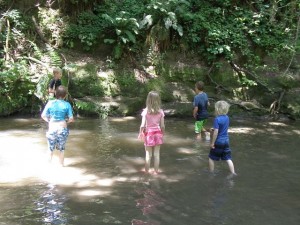OK, it’s official. Although the equinox is not happening for some time yet, it’s summer in California. We even had a lovely, sunny day on Memorial Day! Knowing that the rest of California would be on our beach, dropping their garbage, smoking their cigarettes, and running into each other with their boogie boards, we chose to go down in the woods. It was lovely, warm, and free of distractions.

Our play was largely in the shade, but this was probably a day that lots of kids got their first sunburn of the season. Many of us who are parents now remember a time when it was considered somewhat “fun” to get your “first sunburn.” You showed off how red you were, exclaimed about how it was peeling, and watched hopefully for a tan underneath. If you’re as pale as I am, that tan never materialized, but you hoped nonetheless.
We know better now, or we should. Sunburns in childhood are one of the top risk factors for developing skin cancer later in life. However, it’s hard to think of our kids as 40-year-olds with jobs, mortgages, kids of their own, and out of control skin cells eating up their bodies. And it’s even harder for our kids to take seriously a risk the consequences of which don’t kick in for many years to come.
The risk, however, is real and deadly. And there are only three known ways of avoiding or minimizing the risk if you live in a place that gets strong sunshine:
1) Don’t go out in the sun
This is highly impractical, especially for those of us who live in places where the sun shines even in winter. And besides, being out in nature is so good for us! But we can limit our time in direct sunlight in the middle of the day.
2) Use sunscreen
It’s becoming common for purveyors of sketchy science to point out that sunscreens may cause cancer, but the fact is, people aren’t dying of using sunscreen too much; they’re dying of not using it. Yes, of course, you could damage yourself with too much sunscreen the same way you can damage yourself with too much broccoli, but you’d have to try really hard. And don’t get me started about so-called “natural” sunscreens. Either they’re not really natural at all (there is nothing natural about micronized zinc!), or they’re ineffective folk remedies (sure people in China might think that dousing your kid in tea protects the skin, but you don’t see the FDA approving green tea as a sunscreen). Sunscreen is not natural, but it does help shield our skin against some of the worst of the sun’s damage.
3) Cover up
There was an article in the New York Times today about the increasing popularity of sunscreen-infused clothing, laundry detergent, and shampoo. Weird. A plain old tightly woven shirt will do the job. A hat with a big brim (no baseball caps!) is a must. Swim shirts with long sleeves are best, but those with short sleeves will at least protect the most vulnerable spots.
I was talking recently with a woman with brown skin and freckles, and she told me that she’d never thought of wearing sunscreen before she’d read about her risk factors. Everyone, even people with brown skin, should be aware of the risks and be minimally able to spot unusual growths on their skin. Though brown-skinned people get skin cancer much less often, they die of it much more often because they are likely to ignore unusual spots.
So there’s my yearly lecture. Go out and enjoy the sunshine, but don’t celebrate the first sunburn of the season. Try to make this year the one when there are no sunburns to celebrate or regret.